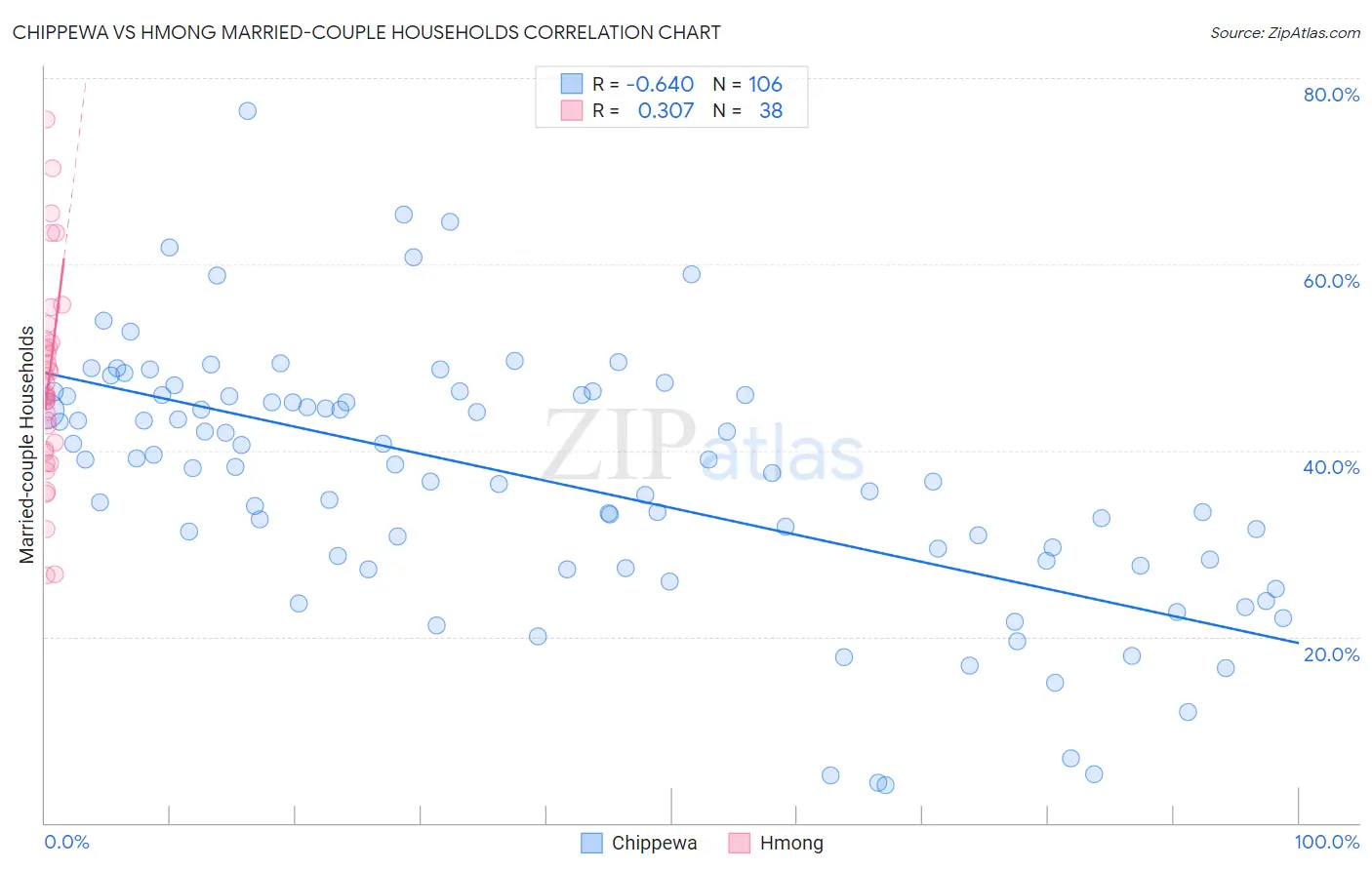Chippewa vs Hmong Married-couple Households
COMPARE
Chippewa
Hmong
Married-couple Households
Married-couple Households Comparison
Chippewa
Hmong
42.1%
MARRIED-COUPLE HOUSEHOLDS
0.0/ 100
METRIC RATING
287th/ 347
METRIC RANK
47.0%
MARRIED-COUPLE HOUSEHOLDS
76.2/ 100
METRIC RATING
153rd/ 347
METRIC RANK
Chippewa vs Hmong Married-couple Households Correlation Chart
The statistical analysis conducted on geographies consisting of 214,993,605 people shows a significant negative correlation between the proportion of Chippewa and percentage of married-couple family households in the United States with a correlation coefficient (R) of -0.640 and weighted average of 42.1%. Similarly, the statistical analysis conducted on geographies consisting of 24,669,739 people shows a mild positive correlation between the proportion of Hmong and percentage of married-couple family households in the United States with a correlation coefficient (R) of 0.307 and weighted average of 47.0%, a difference of 11.4%.

Married-couple Households Correlation Summary
| Measurement | Chippewa | Hmong |
| Minimum | 4.0% | 26.6% |
| Maximum | 76.5% | 75.6% |
| Range | 72.5% | 49.0% |
| Mean | 36.8% | 47.3% |
| Median | 38.4% | 46.0% |
| Interquartile 25% (IQ1) | 28.2% | 40.1% |
| Interquartile 75% (IQ3) | 45.9% | 51.6% |
| Interquartile Range (IQR) | 17.7% | 11.5% |
| Standard Deviation (Sample) | 13.8% | 10.7% |
| Standard Deviation (Population) | 13.7% | 10.6% |
Similar Demographics by Married-couple Households
Demographics Similar to Chippewa by Married-couple Households
In terms of married-couple households, the demographic groups most similar to Chippewa are Immigrants from Eritrea (42.1%, a difference of 0.080%), Sudanese (42.1%, a difference of 0.14%), Honduran (42.1%, a difference of 0.19%), Paiute (42.1%, a difference of 0.20%), and Belizean (42.2%, a difference of 0.24%).
| Demographics | Rating | Rank | Married-couple Households |
| Immigrants | Ecuador | 0.0 /100 | #280 | Tragic 42.9% |
| Immigrants | Guatemala | 0.0 /100 | #281 | Tragic 42.8% |
| Bermudans | 0.0 /100 | #282 | Tragic 42.4% |
| Inupiat | 0.0 /100 | #283 | Tragic 42.4% |
| Cheyenne | 0.0 /100 | #284 | Tragic 42.3% |
| Ghanaians | 0.0 /100 | #285 | Tragic 42.2% |
| Belizeans | 0.0 /100 | #286 | Tragic 42.2% |
| Chippewa | 0.0 /100 | #287 | Tragic 42.1% |
| Immigrants | Eritrea | 0.0 /100 | #288 | Tragic 42.1% |
| Sudanese | 0.0 /100 | #289 | Tragic 42.1% |
| Hondurans | 0.0 /100 | #290 | Tragic 42.1% |
| Paiute | 0.0 /100 | #291 | Tragic 42.1% |
| Indonesians | 0.0 /100 | #292 | Tragic 42.0% |
| Menominee | 0.0 /100 | #293 | Tragic 42.0% |
| Immigrants | Yemen | 0.0 /100 | #294 | Tragic 42.0% |
Demographics Similar to Hmong by Married-couple Households
In terms of married-couple households, the demographic groups most similar to Hmong are Immigrants from Western Asia (46.9%, a difference of 0.0%), Serbian (47.0%, a difference of 0.010%), Arab (46.9%, a difference of 0.010%), Immigrants from Bulgaria (47.0%, a difference of 0.030%), and Armenian (46.9%, a difference of 0.040%).
| Demographics | Rating | Rank | Married-couple Households |
| Immigrants | Western Europe | 81.6 /100 | #146 | Excellent 47.1% |
| Immigrants | Syria | 81.6 /100 | #147 | Excellent 47.1% |
| Icelanders | 79.5 /100 | #148 | Good 47.0% |
| Paraguayans | 78.7 /100 | #149 | Good 47.0% |
| Immigrants | Russia | 77.6 /100 | #150 | Good 47.0% |
| Immigrants | Bulgaria | 76.8 /100 | #151 | Good 47.0% |
| Serbians | 76.3 /100 | #152 | Good 47.0% |
| Hmong | 76.2 /100 | #153 | Good 47.0% |
| Immigrants | Western Asia | 76.1 /100 | #154 | Good 46.9% |
| Arabs | 76.0 /100 | #155 | Good 46.9% |
| Armenians | 75.4 /100 | #156 | Good 46.9% |
| Immigrants | Oceania | 74.8 /100 | #157 | Good 46.9% |
| Immigrants | Nonimmigrants | 73.3 /100 | #158 | Good 46.9% |
| Osage | 73.2 /100 | #159 | Good 46.9% |
| Iraqis | 71.7 /100 | #160 | Good 46.9% |